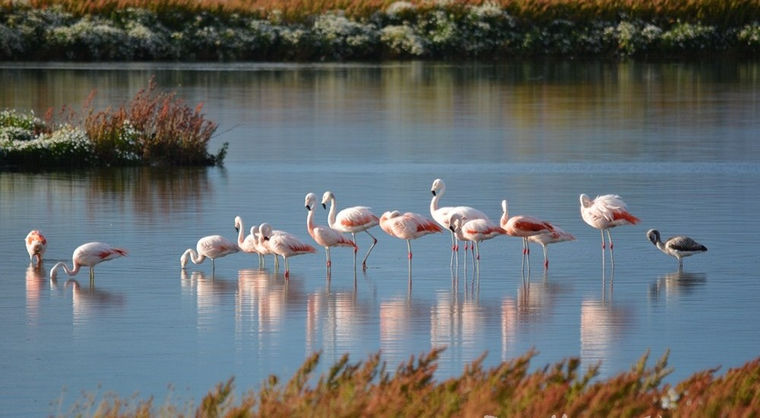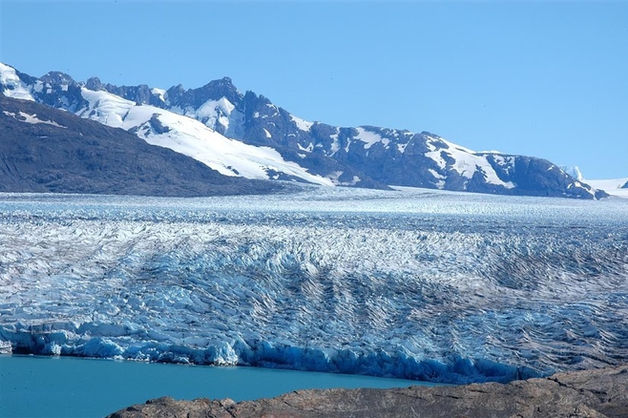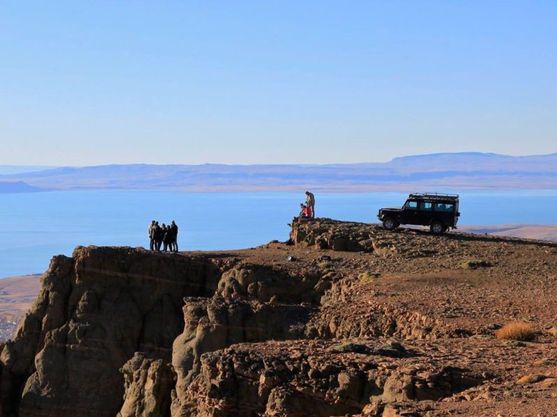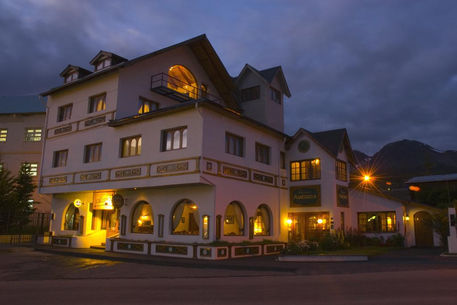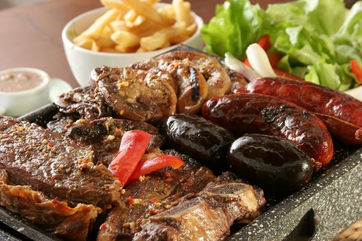SOUTHERN PATAGONIA 10 days, 9 nights
El Calafate (2 nights) ↠ Puerto Natales (2 nights) ↠ Punta Arenas
↠ Ushuaia (2 nights) ↠ Río Gallegos ↠ El Calafate
Forget the stress of everyday life, take a little break to spend a few days in fabulous landscapes !
The Southern Patagonia is a world apart, magical, where nature reigns supreme and offers some of the most beautiful landscapes on the planet, with its majestic mountains at the end of the Andean Cordillera, the Strait of Magellan and the Patagonian steppe that leads to the “end of world city” Ushuaia.
HIGHLIGHTS
-
The Perito Moreno, the glacier that goes forward and shatters under your eyes…
-
Full day boat excursion on Lake Argentino in the midst of giant icebergs to huge glaciers Upsala & Spegazzini
-
Happy hour in the Glaciobar (-10°C=14°F), with special clothing and footwear…
-
Sporty off-road excursion to Balcones de El Calafate, offering a great panoramic view to Cerro Huyliche and El Calafate
-
Torres del Paine National Park, a paradise for trekking, fauna and flora observation and photography.
-
Walk on the Costanera, in Punta Arenas, at the edge of the Strait of Magellan, which the greatest navigators challenged with their boats to access posterity
-
Fantastic drive in a no man´s land to the “end of world city” Ushuaia
-
Tierra del Fuego National park, the most southern park on the planet and the only one in Argentina with a combination of mountains, forest and sea.
Route Map

D1 Arrival in El Calafate A
D2 Full day in El Calafate
D3 El Calafate - Perito Moreno Glacier - Puerto Natales B (430 km)
D4 Full day in Torres Del Paine C (200 km)
D5 Puerto Natales - Punta Arenas D (295 km)
D6 Punta Arenas - Porvenir E - Ushuaia F (441 km)
D7 Full day in Ushuaia F (25 km)
D8 Ushuaia - Río Gallegos G (580 km)
D9 Río Gallegos - El Calafate A (305 km)
GUIDE-COORDINATOR IN YOUR RENTAL CAR : Yes or No ?
* The guide-coordinator is permanently at your disposition.
* He/she speaks several languages, including necessarily English and the language of the country, this can be very helpful if you do not master it enough.
* He/she knows the route and stops at the best points of view.
* If necessary, he/she activates external services (insurance, mechanical repair, rescue,...).
* He/she takes care of check-in and check-out in hotels, restaurant orders, tourist sites entrance fees,...
* In the event of a puncture or a simple problem on the vehicle, he/she is the first to roll up his/her sleeves !
* Last but not least... He/she tells you about the country, the regions crossed, or even the places visited (when there is no local professional guide).
GUIDE-COORDINATOR IN AN ASSISTANCE VEHICLE : Yes or No ?
* The guide-coordinator is in the assistance vehicle, bringing all the advantages mentioned above.
* The assistance vehicle opens the convoy and carries the first aid kit, any excess luggage,... and basic accessories (rope...) in case your car gets stuck in sand or mud.
* In the event of a breakdown or incident on your vehicle, the assistance vehicle can go in search of help or take all or part of the occupants of your vehicle to the next town or stage.
BUT... If you prefer adventure in a small closed group (not alone) and you speak the language of the country, you can do without a guide and assistance vehicle. You will have maps and GPS in the car, the same advanced logistics (vehicle rental, hotels,...), and a 24-hour hotline to resolve any unforeseen event.
Accommodation
Comfortable single, double, twin suites with breakfast included and personalized customer service
Charming Hotels, Spas and Resorts in quiet and lovely areas, preferably surrounded by nature
History & Culture
Patagonia is known as a land of explorers, navigators and adventurers, but it is historically the land of the Amerindians. Since the first traces of human civilization around 35,000 BC, several tribes inhabited the region, mainly between 12,000 and 8,000 BC : the Picunches (the largest Mapuche community of that time), the Huilliches and Chonos in central Patagonia; the Onas, the Yagans and the Alacufes in southern Patagonia; and the Mánekenkes who lived in Tierra del Fuego for 10,000 years. In the Andes, these populations hunted guanacos, llamas, rheas and two extinct species : the mylodons (big bears with camelid heads) and hippidion horses. On the coast, they lived fishing on lenga bark canoes and also fed on Lhao-Lhao mushrooms.
After the discovery of the strait linking the Pacific and Atlantic oceans by the Portuguese navigator Fernando de Magellan in 1520, Patagonia became the scene of conflicts between the Mapuche Indians and the Spanish colonizers led by Pedro de Valdivia, who died in 1553, a year before the Mapuches of the chief Lautaro win the battle of Marihueñu. The Mapuches reconquered most of Araucania but the clashes continued until the nineteenth century, without, however, harming the progressive evangelization of Amerindians.

Local Gastronomy
While enjoying fantastic landscapes, we can also feast on delicious local gastronomy !
Prices 2025
If you are interested in this trip, contact us directly, we will be happy to answer all your questions !
PRICE PER PERSON (With accommodation in double/twin suite)
1 person in the rental vehicle (Single suite included) $ 7.695
2 persons in the rental vehicle $ 4.585
3 persons in the rental vehicle $ 3.810
4 persons in the rental vehicle $ 3.425
Supplement for Single suite $ 789
PRICE FOR THE GROUP (Optional)
Guide-coordinator in the rental vehicle $ 4.450
Guide-coordinator in Assistance Vehicle $ 6.145
* Fixed prices established in $ (USD)
** Payment by bank transfer directly to our account (amount converted into your local currency at the daily exchange rate)
The invoice for your purchase will be sent to you by e-mail after your payment.
Included
-
All activities inside the program
-
Premium accomodation with breakfast
-
Rental vehicle
-
Ferry to cross the Strait of Magellan
-
Radio/GPS
-
National Parks entrance fees (Los Glaciares, Torres del Paine, Tierra del Fuego)
-
Excursions in the program (All glaciers, Glaciarium, Mylodon cave, canal Beagle, End of the World train)
-
Travel File, organization, coordination
-
Permanent guide-coordinator in rental or assistance vehicle (if you choose these options)
Not Included
-
Flight ticket to/from FTE airport
-
Drinks, lunches and dinners
-
Rental vehicle expenses (fuel, tolls, parkings)
-
Border crossing fees
-
Optional outdoor activities
-
Local taxis & Personal expenses
-
Private Travel insurance
CANCELLATION POLICY
Rescheduling or Cancellation by Customer
Rescheduling (according to availability) :
- Free of charge up to 45 days before the start of your package
- With 25% increase less than 45 days before the start of your package
Cancellation :
- Refund of 50% up to 45 days before the start of your package
- No refund less than 45 days before the start of your package
Rescheduling or Cancellation by Dream Sports Adventure
Dream Sports Adventure reserves the right to cancel the package in case of insufficient registration, force majeure or any other valid reason, and in such circumstances will propose to reschedule according to availabilities or to fully refund the packages already purchased, without however giving entitlement to compensation.


